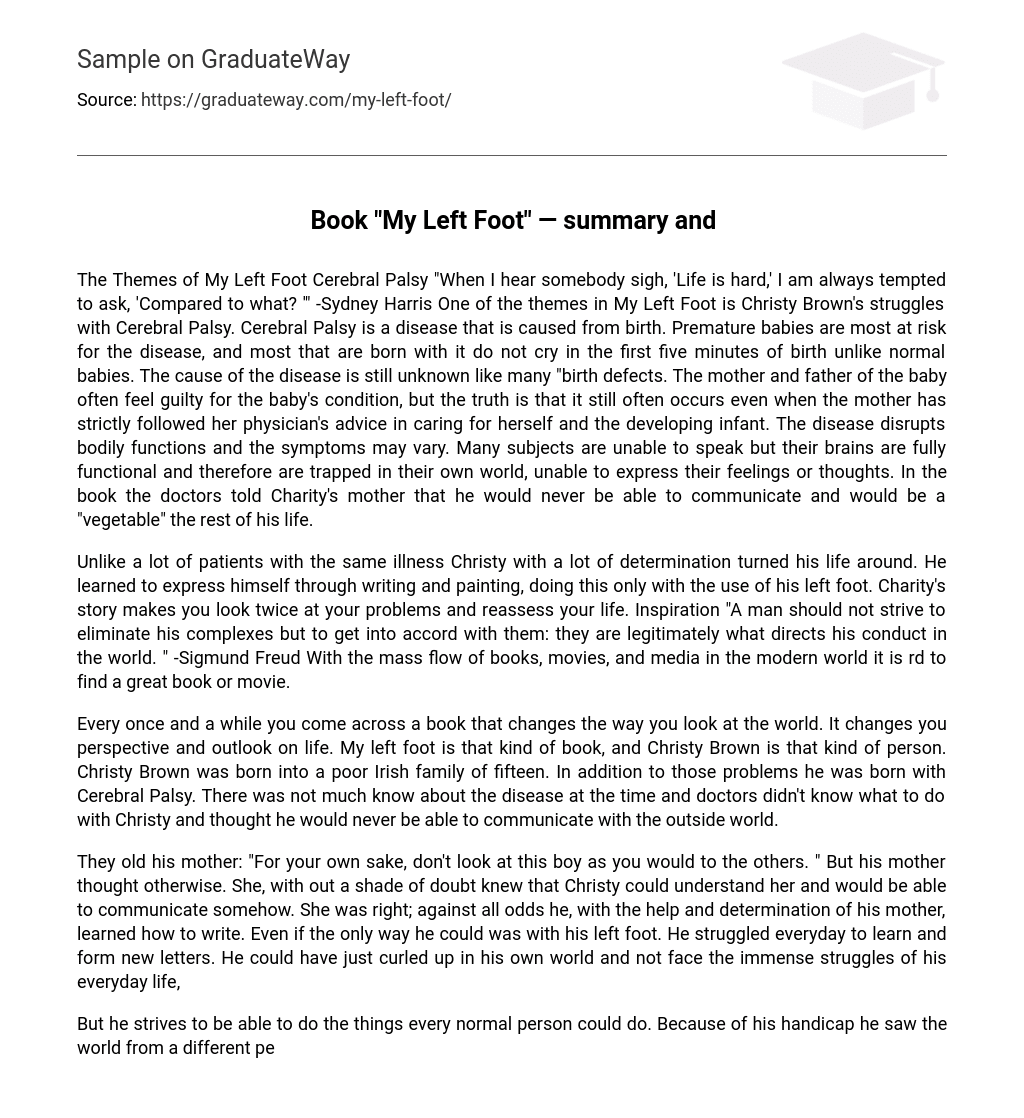The central theme of My Left Foot revolves around the challenges faced by Christy Brown, who has Cerebral Palsy, a condition that occurs at birth. Premature babies are more susceptible to this disease and unlike typical babies, those with Cerebral Palsy do not cry within the first five minutes after being born. The cause of this condition, like many other “birth defects,” remains unknown. Parents of affected infants often experience feelings of guilt, even if they have diligently followed their doctor’s advice during pregnancy.
Cerebral Palsy affects bodily functions and its symptoms can vary. Although individuals with this condition often struggle to speak, their brains function fully. As a result, they are confined to their own world and unable to articulate their thoughts or emotions.
In the book, Charity’s mother is informed by doctors that he will never be able to communicate and will live as a “vegetable” for the rest of his life.
Christy’s journey was different from other patients with the same illness, but it brought about a remarkable change in his life because of his unwavering determination. Using only his left foot, he managed to unlock his creative talents in writing and painting. The story of Charity serves as an inspiration for individuals to reassess their own challenges and alter their perspective on life. As suggested by Sigmund Freud, instead of trying to eliminate our insecurities, we should strive for harmony with them since they greatly influence our behavior in the world. In today’s society, where there is an abundance of books, movies, and media, finding truly exceptional ones can be quite challenging.
At times, a book can have a profound impact on someone’s outlook on life, altering their perception of the world. “My Left Foot” is one such book that exemplifies this transformative quality, similar to how Christy Brown personifies it. Growing up in a poverty-stricken Irish family with fifteen members and burdened by Cerebral Palsy, Christy encountered countless obstacles. However, due to the limited understanding of his condition during that era, healthcare experts questioned his capability to communicate and engage with others.
“Do not view this boy in the same way as others,” they cautioned his mother. Nevertheless, she disagreed, holding a strong belief that Christy possessed the ability to comprehend her and discover a means of communication. Her conviction was validated; despite unfavorable circumstances, through her resolute encouragement and persistence, he acquired the skill of writing – albeit with his left foot. Each day presented difficulties as he tirelessly endeavored to grasp unfamiliar letters. He had the option to withdraw into his own realm, evading the tremendous obstacles of everyday existence.
Despite his handicap, he has a desire to carry out everyday tasks like any other individual. His book about his life captures his distinctive viewpoint on the world, shaped by his disability. Currently, he inspires others through his motivational story and serves as a source of motivation. By observing the obstacles he faces, we gain a fresh outlook on our own difficulties and are spurred to push ourselves harder. Regrettably, many people tend to fear and feel uneasy around individuals with severe disfigurement and disabilities due to their departure from societal norms.
Christy Brown grew up without knowing why people would stare, snicker, or kick him away. He knew he was different but couldn’t comprehend why. He was unfamiliar with the peculiar illness that afflicted him daily. The mere thought of the emotions he must have experienced fills me with sorrow. In his childhood, his siblings and friends would drag him around in a worn-out wagon known as “The Chariot,” and he would happily participate in their games and laughter. However, the wagon eventually broke from overuse, isolating him from the outside world.
But, as he had always done before, he discovered solace in painting, finding a sense of normality in the midst of his struggles. With age, he started perceiving himself differently, grasping the reasons behind the disconcerting gazes targeted at him. He comprehended the nature of his illness, realizing that no matter how much effort he exerted, assimilating like others would forever remain unattainable. A period of deep depression ensued, steadily worsening over time. Despite fleeting moments of happiness, he perpetually recognized his inherent peculiarity in the eyes of others.





